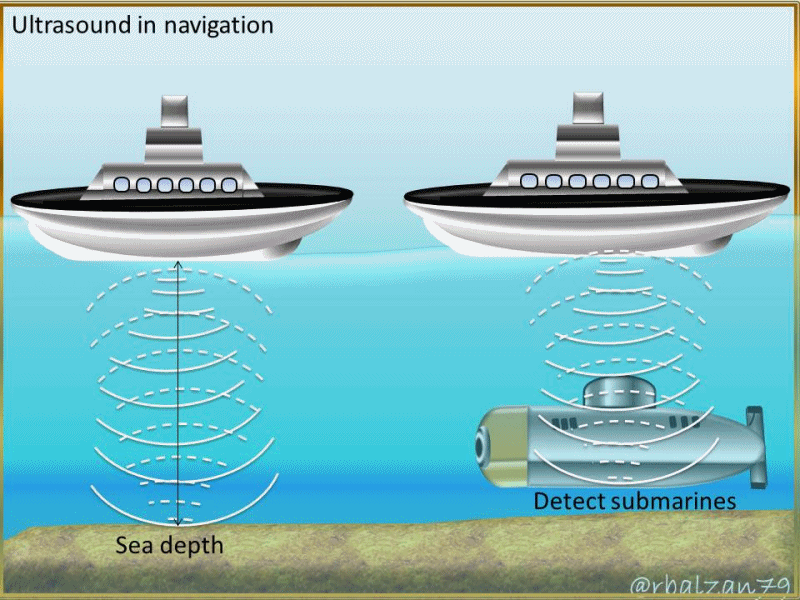Educating ourselves with ultrasound / Application in navigation

Introduction
Every human being with normal hearing conditions is a reliable witness of any audible sound that is generated in their environment, however, there are vibrations that generate sound waves that our ears can not pick up, such is the case of ultrasound, and this is because this frequency is above 20,000 Hz, ie, out of our hearing range.
As we all know, sound can be generated both naturally and artificially, and the latter has allowed us to apply it in various activities related to our daily lives, where there are important areas of application such as medicine, industry, navigation, among many others.
In previous articles we related to the phenomenon of reflection of sound waves generating the recognized echoes, this phenomenon of reflection can be developed in any of the spectral fractions of sound, ie infrasound, audible sound and ultrasound, this feature has allowed us to implement the ultrasound in essential fields of our development as medicine.
Through ultrasound, the world of medicine has been able to analyze the functioning of some of our internal organs, generating important images through ultrasound, a clear example of this type of ultrasound application is the one we find when evaluating the state of a baby during gestation, as well as when performing evaluations of heart rates through echocardiograms.
Application of ultrasound in navigation
We could say that there are many applications of ultrasound in different activities of man, and this makes us highlight the importance in our existence, when we talk about the phenomenon of ultrasound reflection we refer to the fact when these ultrasonic sound waves try to pass from a certain material medium to another with different characteristics of acoustic resistance, where some energy will be absorbed by the medium but the other bounces or is reflected to the same initial medium.
Going into context we can say that this type of ultrasound application was used in navigation in the early twentieth century, thus developing the first transducer (hydrophone) piezoelectric crystal as quartz, and at that time was in order to detect submarines.
This feature allowed the detection of objects on the seabed, as well as schools of fish, and the relief of the seabed in certain areas, all this through the emission of ultrasonic waves, which are then captured in the form of echoes, as shown in the following figure 1.

In the following figure 1, they could observe the action of an acoustic device such as the sonar which sends ultrasound sound waves which upon colliding with some objects or bodies such as fish, some type of vegetation and even with the seabed, they bounce or are reflected, this is what allows to measure the round trip time of these waves upon colliding with these objects mentioned above.
Conclusion
An important aspect to highlight are the extraordinary advances that have been made in the field of science-technology, which is why technology is nothing more than applied science, and thus, ultrasonic sound waves have become a very easy to use tool, and also very powerful, as they have allowed us to study or analyze places that are very difficult to access as is the case of the seabed.
In the previous installment we saw how some animals are able to emit this type of sound naturally either to communicate or to orient themselves, this feature can be found in artificial applications such as sonar, and thanks to this technique the nautical world has been able to explore the vast space below their vessels and thus to navigate more reliably, to name an example.
Until another opportunity my dear readers of @Hive.blog.
Note: The images are my own and were created using Power Point and the animated gif was created with the PhotoScape application.
Recommended Bibliographic References
[2]Specular and diffuse sound reflection. Author: @rbalzan79.
[3]Sound absorption. Author: @rbalzan79.
[4]Sound transmission. Author: @rbalzan79.
[5]Sound diffraction. Author: @rbalzan79.
[6]Sound refraction. Author: @rbalzan79.
[7]Acoustic or sound spectrum. Author: @rbalzan79.
[8]The human ear and sound. Author: @rbalzan79.
[9]Infrasound.Author:@rbalzan79.
[10]Educating ourselves with infrasound, Some sources of generation. Author:@rbalzan79.
Thank you for your valuable support. Best regards